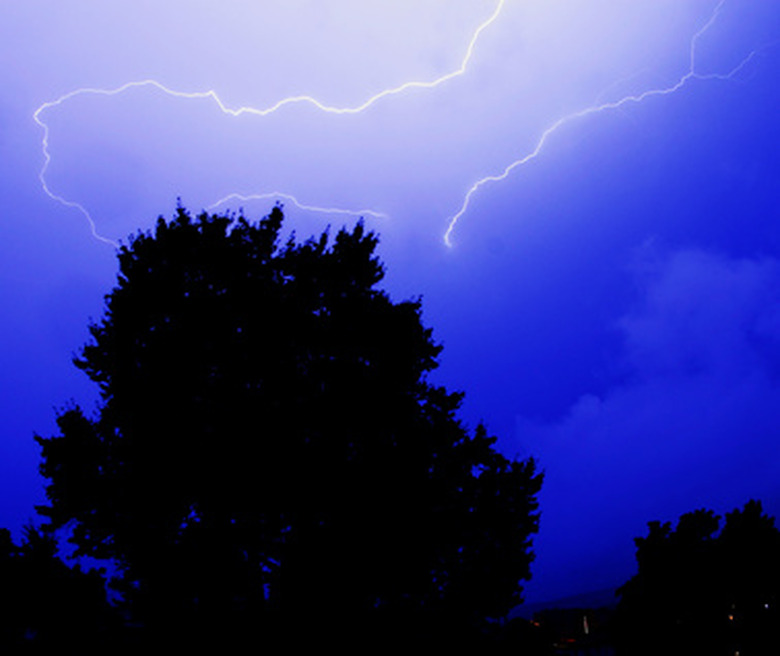What Is The Difference Between Rolling & Clap Thunder?
The primal bellow of thunder is one of the most familiar and impressive elements of our planet's soundscape – and ear-splitting enough at close range to send more than a few dogs, children and, yes, even grownups scrambling for cover.
The wide range of words we use to describe thunder's sounds – boom, crack, clap, roll, peal, rumble, grumble, roar – reflect the fact that what we hear a lightning bolt produce varies in volume, sharpness and duration.
The different sounds are due to our position in relation to the thunderbolt in question and the effect of air density, objects and other physical factors.
The Cause of Lightning
The Cause of Lightning
The electrical discharge called lightning occurs in thunderstorms thanks to the tumultuous air movement that occurs within them. Ice crystals and the iced-over snowflakes called graupel collide with one another within the thundercloud (cumulonimbus), resulting in the crystals becoming positively charged and the graupel becoming negatively charged.
Updrafts carry the ice crystals into the crown of the thunderhead while the heavier graupel concentrates in middle and lower layers, meaning the top of the now-electrified cloud develops a positive charge and the bottom a negative one.
Voltage builds up between oppositely charged areas, causing lightning flashes within the thunderhead as well as between clouds. These in-cloud and cloud-to-cloud discharges account for most of the lightning in a storm, but cloud-to-ground strikes also occur.
These happen because like charges repel one another, which means the negatively charged bottom of the thundercloud displaces negative charges from the ground below while attracting positive charges.
The air in between initially insulates from electrical discharge, but once the voltage builds up enough, an initial stream of negative charges – the pilot leader – flows from the cloud belly to the ground. As the flow continues, channels for the movement of charged particles develop between the cloud and the ground in the form of stepped leaders.
The return stroke is the powerful surge of current from the ground back to the cloud along these channels, which produces the blazing flash we see as lightning.
The Source of Thunder
The Source of Thunder
The discharge of the return stroke heats the air around the voltage channel to some 50,000 degrees Fahrenheit. This extremely rapid heating creates a violent expansion of the air that rockets outward from the lightning bolt like a shockwave. That explosive shockwave and resulting compression produce the sound of thunder.
Because the speed of light is faster than the speed of sound, we see the flare of lightning before we hear the resulting thunder; the interval between the flash and the boom represents the distance of the observer from the bolt. Every five seconds you can count between the lightning and thunder represents about 1 mile.
Clapping and Rolling Thunder
Clapping and Rolling Thunder
You can typically hear thunder from a storm within about 15 miles of your position, occasionally farther out. Cloud-to-ground lightning that discharges fairly close to you will produce a sharp clap or crackle of thunder as the strong sonic shockwave from the part of the bolt nearest your position reaches you first.
A drawn-out, subsiding roll of thunder follows as your ear registers shockwaves from higher and more distant parts of the bolt's channel.
The volume fluctuations of rolling thunder can be due to the zigzag and often forked shape of a bolt, differences in air density along the mostly vertical lightning channel and soundwaves bouncing off clouds, mountainsides and other obstacles – a combination of sound dulled and distorted by distance as well as echoes.
If you're some distance from a thunderstorm, you may only hear rolling or pealing thunder. Lightning you can see but that's too far off to hear as thunder is often called heat lightning, though rest assured it's still making noise.
Cite This Article
MLA
Shaw, Ethan. "What Is The Difference Between Rolling & Clap Thunder?" sciencing.com, https://www.sciencing.com/difference-between-rolling-clap-thunder-6906574/. 22 November 2019.
APA
Shaw, Ethan. (2019, November 22). What Is The Difference Between Rolling & Clap Thunder?. sciencing.com. Retrieved from https://www.sciencing.com/difference-between-rolling-clap-thunder-6906574/
Chicago
Shaw, Ethan. What Is The Difference Between Rolling & Clap Thunder? last modified March 24, 2022. https://www.sciencing.com/difference-between-rolling-clap-thunder-6906574/
